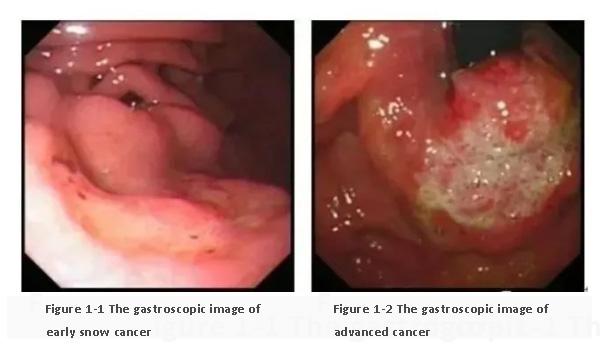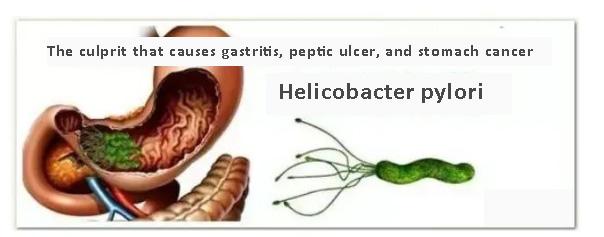Peptic ulcer mainly refers to the chronic ulcer that occurs in the stomach and duodenal bulb. It is named because the formation of ulcer is related to the digestion of gastric acid and pepsin, which accounts for about 99% of peptic ulcer.
Peptic ulcer is a common benign disease with worldwide distribution. According to statistics, duodenal ulcers tend to occur in young adults, and the age of onset of gastric ulcers is later, on average, about 10 years later than that of duodenal ulcers. The incidence of duodenal ulcers is about 3 times that of gastric ulcers. . It is generally believed that some gastric ulcers will become cancerous, while duodenal ulcers generally do not.
Figure 1-1 The gastroscopic image of early snow cancer Figure 1-2 The gastroscopic image of advanced cancer.
1. Most peptic ulcers are curable
In patients with peptic ulcer, most of them can be cured: about 10%-15% of them have no symptoms, while most patients have typical clinical manifestations, namely: chronic, rhythmic onset of periodic onset in autumn and winter and winter and spring stomach ache.
Duodenal ulcers often present with rhythmic fasting pain, while gastric ulcers often present with postprandial pain. Some patients usually lack typical clinical manifestations, and their first symptoms are hemorrhage and acute perforation.
Upper gastrointestinal angiography or gastroscopy can often confirm the diagnosis, and combined medical treatment with acid suppressants, gastric mucosal protective agents, and antibiotics can make most patients recover.
2.Recurrent stomach ulcers are considered precancerous lesions
Gastric ulcers have a certain cancer rate. It mainly occurs in middle-aged and older, male, recurring ulcers that cannot be cured for a long time. In fact, pathological biopsy should be carried out for all gastric ulcers in clinical practice, especially the above-mentioned ulcers. Anti-ulcer treatment can only be carried out after canceration must be excluded, in order to prevent misdiagnosis and delay of the disease. Furthermore, after gastric ulcer treatment, re-examination should be carried out to observe changes in ulcer healing and adjust treatment measures.
Duodenal ulcers rarely become cancerous, but recurrent gastric ulcers are now considered by many experts to be a precancerous lesion.
According to Chinese literature reports, about 5% of gastric ulcers can become cancerous, and this number is currently increasing. According to statistics, up to 29.4% of gastric cancers come from gastric ulcers.
Studies have found that gastric ulcer cancer patients account for about 5%-10% of gastric ulcer incidence. Generally speaking, most patients with gastric ulcer canceration have a long history of chronic gastric ulceration. Repeated destruction of epithelial cells at the edge of the ulcer and mucosal repair and regeneration, metaplasia, and atypical hyperplasia increase the possibility of canceration over time.
Cancer usually occurs in the surrounding mucosa of ulcers. The mucosa of these parts erodes when the ulcer is active, and can become malignant after repeated destruction and regeneration. In recent years, due to the progress of diagnosis and examination methods, it has been found that the early gastric cancer confined to the mucosa can be eroded and ulcerated, and its tissue surface can be changed by secondary peptic ulcers. These cancerous ulcers can be repaired like benign ulcers. and repair can be repeated, and the course of the disease can be extended for several months or even longer, so gastric ulcers should be paid great attention.
3. What are the signs of malignant transformation of gastric ulcer?
1. Changes in the nature and regularity of pain:
The pain of gastric ulcer is mostly manifested as a dull pain in the upper abdomen, which is burning or dull, and the onset of the pain is related to eating. If the pain loses the above-mentioned regularity, becomes irregular attacks, or becomes persistent dull pain, or the nature of pain has changed significantly compared with the past, it should be alert to the harbinger of cancer.
2. Ineffective with anti-ulcer drugs:
Although gastric ulcers are prone to recurring attacks, the symptoms are generally relieved after taking anti-ulcer drugs.
3. Progressive weight loss patients:
In the short term, loss of appetite, nausea, vomiting, fever and progressive weight loss, weight loss, the possibility of cancer is very high.
4. Hematemesis and melena appear:
The patient’s recent frequent vomiting of blood or tarry stools, persistently positive fecal occult blood test results, and severe anemia suggest that gastric ulcers may be turning into cancer.
5. Masses appear in the abdomen:
Patients with gastric ulcers generally do not form abdominal masses, but if they become cancerous, the ulcers will become larger and hardened, and advanced patients can feel the mass on the left upper abdomen. The mass of the mass is often hard, nodular and not smooth.
6.Those who are over 45 years old, have a history of ulcer in the past, and have repeated symptoms recently, such as hiccups, belching, abdominal pain, and are accompanied by weight loss.
7. Positive fecal occult blood:
Repeated positive, be sure to go to the hospital for a comprehensive examination.
8. Others:
More than 5 years after gastric surgery, there are symptoms of indigestion, weight loss, anemia and gastric bleeding, and unexplained upper abdominal distention, belching, discomfort, fatigue, weight loss, etc.
4,The cause of gastric ulcer
The etiology of peptic ulcer is not yet fully understood, but it has been clarified that Helicobacter pylori infection, taking non-steroidal anti-inflammatory drugs and antithrombotic drugs, as well as excessive gastric acid secretion, genetic factors, psychological and emotional fluctuations, and irregular diet Sex, eating snacks, smoking, drinking, geographical environment and climate, chronic diseases such as emphysema and hepatitis B are also related to the incidence of peptic ulcer.
1. Helicobacter pylori (HP) infection:
Marshall and Warren won the 2005 Nobel Prize in Medicine for successfully culturing Helicobacter pylori in 1983 and suggesting that its infection plays a role in the pathogenesis of peptic ulcers. A large number of studies have fully proved that Helicobacter pylori infection is the main cause of peptic ulcer.
2. Drug and dietary factors:
Long-term use of drugs such as aspirin and corticosteroids is prone to cause this disease. In addition, long-term smoking, long-term drinking, and drinking strong tea and coffee seem to be related.
(1) Various aspirin preparations: Long-term or high-dose use can cause stomach pain and discomfort. In severe cases, hematemesis, melena, etc., can be found in gastric mucosal inflammation, erosion and ulcer formation.
(2) Hormone replacement drugs:
Drugs such as indomethacin and phenylbutazone are hormone replacement drugs, which have direct damage to the gastric mucosa and can lead to acute gastric ulcers.
(3) Antipyretic analgesics:
Such as A.PC, paracetamol, pain relief tablets and cold medicines such as Ganmaotong.
3. Stomach acid and pepsin:
The final formation of peptic ulcers is due to the self-digestion of gastric acid/pepsin, which is the decisive factor in the occurrence of ulcers. The so-called “acid-free ulcers”.
4. Stressful mental factors:
Acute stress can cause stress ulcers. People with chronic stress, anxiety, or mood swings are prone to peptic ulcers
ulcer.
5. Genetic factors:
In some rare genetic syndromes, such as multiple endocrine adenoma type I, systemic mastocytosis, etc., peptic ulcer is part of its clinical manifestations.
6. Abnormal gastric motility:
Some gastric ulcer patients have gastric motility disorders, such as increased gastric acid secretion caused by delayed gastric emptying and duodenal-gastric reflux caused by bile, pancreatic juice and lysolecithin damage to the mucosa.
7. Other factors:
Such as local infection of herpes simplex virus type I may be related. Cytomegalovirus infection may also be involved in renal transplants or immunocompromised patients.
In conclusion, ulcers can be effectively prevented by actively improving lifestyles, taking drugs rationally, eradicating Helicobacter pylori, and taking gastroscopy as a routine physical examination item;
Once an ulcer occurs, it is necessary to actively regulate the treatment and conduct regular gastroscopy review (even if the ulcer is cured), so as to effectively prevent the occurrence of cancer.
“The importance of gastroscopy can generally be used to understand whether the patient’s esophagus, stomach and duodenum have different degrees of inflammation, ulcers, tumor polyps and other lesions. Gastroscopy is also an irreplaceable direct inspection method, and some countries have adopted gastroscopic examination. As a health check-up item, examinations need to be carried out twice a year, because the incidence of early gastric cancer in some countries is relatively high. Therefore, after early detection and timely treatment, the treatment effect is also obvious.”
We, Jiangxi Zhuoruihua Medical Instrument Co.,Ltd., is a manufacturer in China specializing in the endoscopic consumables, such as biopsy forceps, hemoclip, polyp snare, sclerotherapy needle, spray catheter, cytology brushes, guidewire, stone retrieval basket, nasal biliary drainage catheter etc. which are widely used in EMR, ESD, ERCP. Our products are CE certified, and our plants are ISO certified. Our goods have been exported to Europe, North America, Middle East and part of Asia, and widely obtains the customer of the recognition and praise!
Post time: Aug-15-2022




